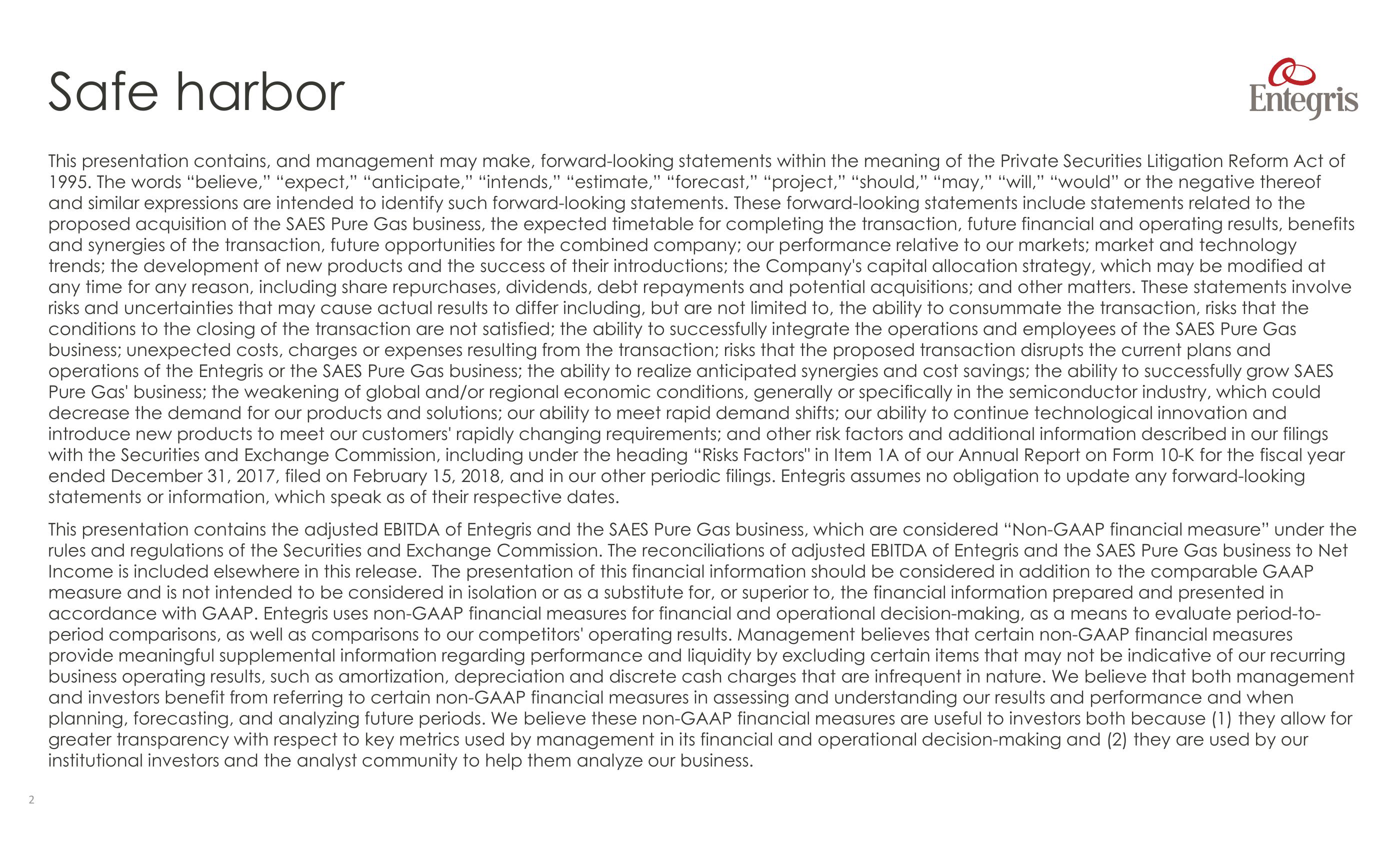Entegris to Acquire SAES Pure Gas business
2
Safe harbor
Entegris
This presentation contains, and management may make, forward-looking statements within the meaning of the Private Securities Litigation Reform Act of
1995. The words "believe," "expect," "anticipate," "intends," "estimate," "forecast," "project," "should," "may," "will," "would" or the negative thereof
and similar expressions are intended to identify such forward-looking statements. These forward-looking statements include statements related to the
proposed acquisition of the SAES Pure Gas business, the expected timetable for completing the transaction, future financial and operating results, benefits
and synergies of the transaction, future opportunities for the combined company; our performance relative to our markets; market and technology
trends; the development of new products and the success of their introductions; the Company's capital allocation strategy, which may be modified at
any time for any reason, including share repurchases, dividends, debt repayments and potential acquisitions; and other matters. These statements involve
risks and uncertainties that may cause actual results to differ including, but are not limited to, the ability to consummate the transaction, risks that the
conditions to the closing of the transaction are not satisfied; the ability to successfully integrate the operations and employees of the SAES Pure Gas
business; unexpected costs, charges or expenses resulting from the transaction; risks that the proposed transaction disrupts the current plans and
operations of the Entegris or the SAES Pure Gas business; the ability to realize anticipated synergies and cost savings; the ability to successfully grow SAES
Pure Gas' business; the weakening of global and/or regional economic conditions, generally or specifically in the semiconductor industry, which could
decrease the demand for our products and solutions; our ability to meet rapid demand shifts; our ability to continue technological innovation and
introduce new products to meet our customers' rapidly changing requirements; and other risk factors and additional information described in our filings
with the Securities and Exchange Commission, including under the heading "Risks Factors" in Item 1A of our Annual Report on Form 10-K for the fiscal year
ended December 31, 2017, filed on February 15, 2018, and in our other periodic filings. Entegris assumes no obligation to update any forward-looking
statements or information, which speak as of their respective dates.
This presentation contains the adjusted EBITDA of Entegris and the SAES Pure Gas business, which are considered "Non-GAAP financial measure" under the
rules and regulations of the Securities and Exchange Commission. The reconciliations of adjusted EBITDA of Entegris and the SAES Pure Gas business to Net
Income is included elsewhere in this release. The presentation of this financial information should be considered in addition to the comparable GAAP
measure and is not intended to be considered in isolation or as a substitute for, or superior to, the financial information prepared and presented in
accordance with GAAP. Entegris uses non-GAAP financial measures for financial and operational decision-making, as a means to evaluate period-to-
period comparisons, as well as comparisons to our competitors' operating results. Management believes that certain non-GAAP financial measures
provide meaningful supplemental information regarding performance and liquidity by excluding certain items that may not be indicative of our recurring
business operating results, such as amortization, depreciation and discrete cash charges that are infrequent in nature. We believe that both management
and investors benefit from referring to certain non-GAAP financial measures in assessing and understanding our results and performance and when
planning, forecasting, and analyzing future periods. We believe these non-GAAP financial measures are useful to investors both because (1) they allow for
greater transparency with respect to key metrics used by management in its financial and operational decision-making and (2) they are used by our
institutional investors and the analyst community to help them analyze our business.View entire presentation